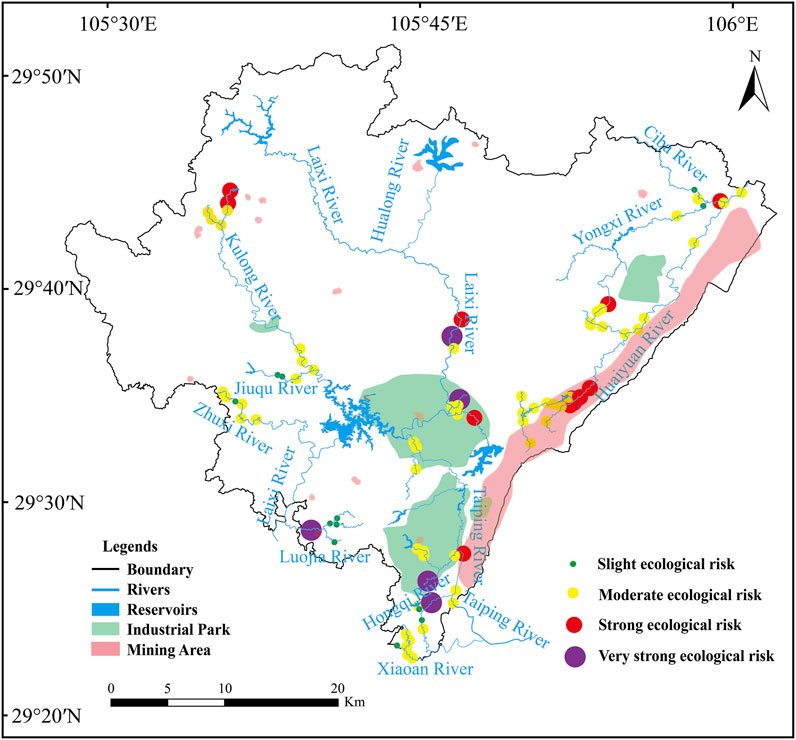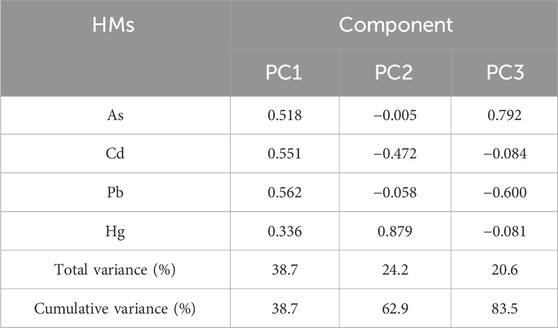- Chongqing Bureau of Geology and Minerals Exploration No.107 Geological Team, Chongqing, China
With the rapid progress of industrialization and urbanization, large amounts of industrial wastewater and mining waste have been discharged into rivers. The problem is especially severe in areas with intensive mineral resource development and hardware manufacturing. Moreover, frequent heavy rainfall and flooding during the flood season significantly increase surface runoff and sediments resuspension, promoting the mobilization and redistribution of heavy metals (HMs) in river systems. Therefore, it is of great practical importance to systematically identify the distribution characteristics and ecological risks of HMs pollution in such regions under changing climatic conditions. Eighty-five surface sediment samples were collected in Southwest China, and the concentrations of As, Hg, Cd, and Pb were determined. The geo-accumulation index (Igeo) and the potential ecological risk index (RI) were used to assess contamination levels and ecological risks, and principal component analysis (PCA) and positive matrix factorization (PMF) were applied to trace pollution sources. The results show that Cd and Hg have similar spatial patterns, with high concentrations mainly downstream of mining areas and industrial parks. Igeo and RI assessments indicate that Hg pollution in sediments is severe in four major rivers of Dazu District, followed by Cd, while As and Pb show relatively low pollution levels. Source apportionment revealed that industrial and traffic-related activities contribute 55.05% of HMs inputs, mining activities account for 41.28%, and natural sources contribute 3.67%. Cd and Pb mainly originate from industrial emissions and traffic, Hg is primarily associated with mining, and As is derived from natural sources.
1 Introduction
Rivers play a key role in surficial environments by controlling material transport between terrestrial and marine ecosystems (Ren et al., 2025). Due to the acceleration of urbanization and industrialization, especially the increase in industrial discharges and urban wastewater, large amounts of untreated or poorly treated wastewater and pollutants enter rivers, posing a significant threat to aquatic ecosystems (Saxena, 2025; Wu et al., 2025). Currently, major pollutants in rivers include nutrients (Nie et al., 2018; Ren et al., 2025), heavy metals (HMs) (Le and Nguyen, 2024; Liu et al., 2023), and organic contaminants (Net et al., 2015; Schwanen et al., 2023; Sousa et al., 2018). HMs have attracted considerable attention due to their high toxicity, persistence, and strong accumulation in sediments (Tu et al., 2023; Yiika et al., 2023; Zheng et al., 2023). HMs pollution threatens aquatic ecosystems and may pose potential risks to human health through the food chain (Ali and Khan, 2019), and has become a global concern.
Sediments serve as both reservoirs and transport media for HMs, making them a critical component in the study of riverine pollution (Shen et al., 2024; Xie et al., 2022). Compared to the overlying water, sediments exhibit stronger accumulation and indicative properties, providing valuable insights into the historical input and spatial distribution of pollutants across the watershed (Li et al., 2022b; Sultana et al., 2025). Through continuous interactions with the surrounding environment and their strong adsorption capacity, sediments can retain HMs for extended periods (Kachoueiyan et al., 2024; Xie et al., 2022). However, these HMs are not permanently immobilized. Extreme weather events such as heavy rainfall, flooding, and prolonged drought can significantly alter hydrological conditions in river systems (Gao et al., 2018; Zhang et al., 2018). These changes enhance the capacity of sediments to resuspend and erode (Li et al., 2022a; Zhang et al., 2018). As a result, HMs previously stored in sediments may be released into the overlying water. This release can significantly affect the mobility, bioavailability, and ecological risk of HMs (Wu et al., 2017). For example, flooding may disturb sediments and mobilize Zn, Pb and Cd that were previously bound to fine particles. Changes in pH or redox conditions can trigger this release, posing potential threats to water environmental safety (Ciszewski, 2001). Therefore, systematic investigations of HMs contamination in sediments are essential for tracing pollution sources, understanding their temporal evolution, and informing watershed management and risk mitigation strategies.
Extensive research has been conducted on HMs pollution in river sediments, and various assessment and analytical methods have been increasingly refined (Dai et al., 2018; Ding et al., 2025; Li et al., 2022c; Nieva et al., 2018). Commonly, methods including geo-accumulation index (Igeo), sediment quality guidelines (SQGs), and the potential ecological risk index (RI) have been widely employed for the evaluation of HMs enrichment levels and associated ecological threats (Gu et al., 2024; Li et al., 2022b). Multivariate statistical methods, such as principal component analysis (PCA) and positive matrix factorization (PMF), are frequently employed to identify pollution sources and quantify source contributions (Liu et al., 2017; Zhao et al., 2020). For example, Li et al. assessed six HMs in the Yellow River using Igeo, SQGs and RI, finding The ecological risk of HMs increases when the Yellow River passes through the Loess Plateau (Li et al., 2022b). Zhao et al. used PCA in the Pearl River Estuary to trace HMs origins to upstream industrial discharges, including metal plating and battery production, while Liu et al. applied PMF in Lingding Bay and the lower Xijiang River to reveal contributions from mixed industrial effluents (Liu et al., 2017; Zhao et al., 2020). Despite these advances, most studies focus on large mainstream rivers or single-source-dominated systems. Small and medium-sized watersheds, particularly those influenced by both industrial parks and mining activities, remain understudied. The distribution, sources, and ecological risks of HMs in such composite-pollution systems have not been systematically characterized. Therefore, selecting representative watersheds with overlapping anthropogenic pressures and conducting comprehensive investigations into sediment contamination and ecological risk is crucial for informing targeted pollution control and restoration strategies.
Dazu District is rich in mineral resources, making mining activities intense and a key pillar of the regional economy. Meanwhile, Dazu is one of China’s largest hardware production bases and distribution centers, featuring a highly developed industrial system with concentrated hardware processing and related industry chains (Ao et al., 2024). Over time, industrial development and resource extraction have released large amounts of heavy metal-containing waste gases, wastewater, and solid waste. These pollutants enter the regional river systems through atmospheric deposition, surface runoff, and groundwater migration (Zhang et al., 2022). This increases HMs input load and raises the accumulation risk of Pb, Cd, As, Hg, and other metals in sediments. Especially during the flood season, heavy rainfall causes increased surface runoff and river flow (Ciszewski, 2001). This enhances the potential for HMs from industrial parks, mines, and polluted soils to migrate and spread into river systems (Frogner-Kockum et al., 2020). The sampling for this study took place during the flood season. The intense and frequent rainfall increased surface runoff and soil erosion (Li et al., 2022a; Zhang et al., 2018). This facilitated the transport of HMs from mining waste and industrial discharges into rivers, leading to significant increases in sediment HMs loads (Poot et al., 2007). Although previous studies have revealed HMs pollution in farmland soils and agricultural products in Dazu District, there is still a lack of systematic research on the geochemical characteristics, pollution sources, and ecological risks of HMs in river sediments under the influence of complex human activities (Liu et al., 2022). This study focuses on river sediments in Dazu District and aims to: (1) analyze the spatial distribution and pollution levels of Pb, Cd, As, and Hg in sediments; (2) identify their potential sources using PCA and PMF; (3) assess the ecological risk based on Igeo and RI. The results will help clarify the distribution and ecological risks of sediment HMs under the joint influence of mining and hardware industries during the flood season. It also fills a research gap in sediment contamination in this region and provides scientific support for pollution control and ecological restoration in Dazu District and other similarly disturbed watersheds.
2 Materials and methods
2.1 Study area
Dazu District is located in the southeastern Sichuan Basin and the northwestern part of Chongqing, China. It lies on the watershed between the Fujiang and Tuojiang Rivers and is the source region of the Laixi River. The main rivers in the district include the Laixi, Kulong, and Huaiyuan Rivers. The terrain is generally elevated in the northwest and southeast. The district has a subtropical humid climate characteristic of the Sichuan Basin. The annual average temperature ranges from 16.5°C to 18.5°C, with an average annual precipitation of 1,163.3 mm. The flood season occurs from June to October, during which rainfall is concentrated (The climatic conditions within the month to sampling are shown in Supplementary Table S1). The average annual wind speed is 1.3 m/s, with the prevailing wind direction being north-northeast (NNE). The district has a registered population of approximately 1.063 million. Its industrial structure mainly comprises four sectors: industry, agriculture, tourism, and commerce. The region is rich in mineral resources, with 19 types of minerals identified, including coal, natural gas, shale, limestone, quartz sandstone, and ceramic clay. In addition, Dazu hosts seven industrial clusters and is home to the largest hardware industrial park in western China.
2.2 Sample collection and processing
Locations of the study area and sampling sites are illustrated in Figure 1. This study focused on river basins within Dazu District, where sampling sites were established in major rivers and tributaries within industrial parks and mining areas. The sampling campaign was carried out during June and July 2024, and a total of 85 surface sediment samples (top 5–30 cm) were collected. In the field, A grab sampler was used to collect sediment samples. Three parallel samples were taken at each site. The samples were thoroughly mixed using a wooden spoon. Then, 500–700 g of the mixed sample was placed in a polyethylene zip-lock bag and sealed, and stored in a portable refrigerator at 4°C for further analysis.
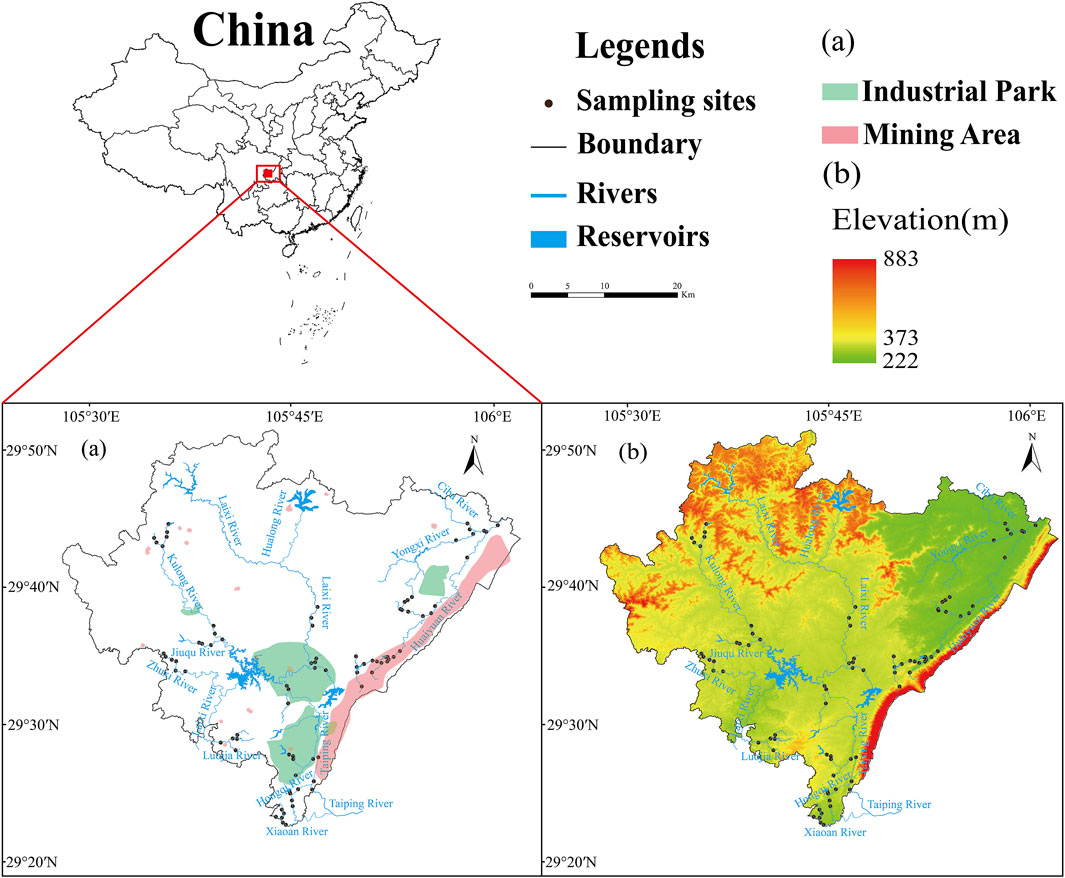
Figure 1. Location of the Dazu District and sampling sites. (a) Distribution of industrial parks and mining areas; (b) Digital Elevation Model of Dazu District.
The sediment samples were analyzed at Chongqing Stand Testing Technology Co., Ltd. After removing impurities, the samples were dehydrated, dried, and ground to pass through a 100-mesh sieve. A random selection of 5% of the total submitted samples was reanalyzed to calculate the relative deviation of duplicate analyses. Routine analytical precision control was conducted using certified national primary standard materials. Four different national primary standard materials were selected and evenly inserted into each analytical batch (50 samples per batch) for simultaneous analysis with the sediment samples. Upon completion of each batch, the logarithmic deviation and logarithmic standard deviation between the measured and certified values for each standard material were calculated to quantify analytical precision. The selection of the four standard materials was based on the characteristics of the study area samples, the types and concentrations of key analytes, and background levels. Standard materials covering high, medium, and low concentrations were chosen for quality control. The acceptable analytical precision rate for each element was required to be ≥ 98%. All sample analyses met the quality control standards set by the monitoring unit. The HMs elements analyzed included Pb, Cd, As, and Hg. The analytical methods and detection limits for each element are presented in Supplementary Table S2.
2.3 Environmental contamination assessment
The Igeo was applied to assess the accumulation level of every HMs investigated in sediments (Muller, 1969). The calculation can be described as follows Equation 1:
where Ci represented the determined content of every HMs i in sediments, Bi represented the background value of stream sediments in China (BSS) (Shi et al., 2016), 1.5 was a modified coefficient (Shen et al., 2024). Contamination levels of HMs are categorized in Supplementary Table S3.
2.4 Sediment quality guidelines
SQGs are widely used to assess the potential biological toxicity of HMs in freshwater sediments (Macdonald et al., 1996). Each pollutant is associated with two benchmark values: the Threshold Effect Level (TEL) and the Probable Effect Level (PEL). These thresholds indicate the likelihood of toxic effects on benthic organisms. When HMs concentrations are below the TEL, adverse biological effects are rare or absent. When concentrations exceed the PEL, toxic effects are likely to occur frequently (Li et al., 2022b). Concentrations between TEL and PEL suggest a potential for biological harm (Li et al., 2022c). The TEL and PEL values for freshwater sediments used in this study are listed in Supplementary Table S4.
2.5 Ecological risk assessment
The RI offers a comprehensive assessment of ecological risks by incorporating HMs’ migration, transformation, and toxicity (Hakanson, 1980; Lin et al., 2016). RI is computed using Equations 2, 3:
where
2.6 Source apportionment methods
PCA were applied to initially identify the sources of HMs (Li et al., 2022b; Liu et al., 2019). The PMF was utilized to further identify and quantify the sources and their contributions of HMs (Equations 4–6) (Dong et al., 2019; Liu et al., 2019; Liu et al., 2017)
where Xij denotes the concentration of HMj in sample i; Q is the minimized objective function; uij indicates the uncertainty for HMj in sample i; gik represents the contribution of source k to sample i, fkj is the concentration of HMj from source k; eij is the residual matrix; RSD refers to the relative standard deviation of the content of HMs; MDL stands for the method detection limit.
3 Results and discussion
3.1 Distribution characteristics of HMs in sediments
3.1.1 Concentration characteristics of HMs
The statistical characteristics of HMs concentrations in river sediments within the study area are presented in Supplementary Table S4. The concentration ranges of Pb, Cd, As, and Hg were 5.20–55.10 mg/kg, 0.02–0.71 mg/kg, 0.87–12.00 mg/kg, and 0.03–0.79 mg/kg, respectively. Their average concentrations follow the order of Pb > As > Cd > Hg, with corresponding values of 23.43 ± 8.32, 3.69 ± 2.30, 0.24 ± 0.1, and 0.09 ± 0.092 mg/kg. Only the concentration of As was below BSS. The average concentrations of Pb, Cd, and Hg were 1.02, 1.84, and 3 times higher than BSS, respectively. This suggests that Pb, Cd, and Hg may be significantly influenced by anthropogenic activities.
Among the 11 rivers in the study area, only a few samples from the Ciba River and Huaiyuan River show mean As concentrations slightly exceeding the BSS (Figure 2). The other rivers had As concentrations below the BSS. Previous studies have shown that the natural geological background and mining activities in upstream mining zones, along with pollutant discharge from industrial parks and local agricultural activities, can all contribute to the enrichment of As (Jia et al., 2018; Yang et al., 2007). In the study area, As concentrations in the upper Huaiyuan River are higher than BSS. No mines or industrial enterprises are present in the anomalous areas. Therefore, As levels are mainly controlled by natural geological background and show no clear signs of external pollution. The average concentrations of Cd and Hg exceeded the BSS in all rivers. Industrial production may release Cd and Hg (Liu et al., 2023; Liu et al., 2024). Mining and tailings leachate may also introduce these metals into surface waters (Chen et al., 2019; Liu et al., 2023). Agricultural activities may increase Cd and Hg input through surface runoff. The application of Cd-containing phosphate fertilizers, organic fertilizers, and livestock manure can introduce Cd and Hg into river systems during rainfall or irrigation. This process contributes to elevated HMs levels in sediments (Liu et al., 2024). Cd and Hg enrichment in the study area may be due to combined effects of industrial discharge, mining activities, and agricultural non-point source pollution. Multiple studies have shown that Pb released from vehicle exhaust can accumulate on the ground through atmospheric deposition. During intense rainfall, surface runoff can transport this Pb into river systems, resulting in increased Pb concentrations in sediments (Hanfi et al., 2019; Liu et al., 2023; Nawrot et al., 2020). This leads to Pb accumulation in sediments. Due to emissions and dust from vehicles used in hardware industry zones and mining areas, Pb input increases. As a result, Pb levels in sediments are generally higher than BSS. Traffic emissions and industrial activities are likely the main reasons.
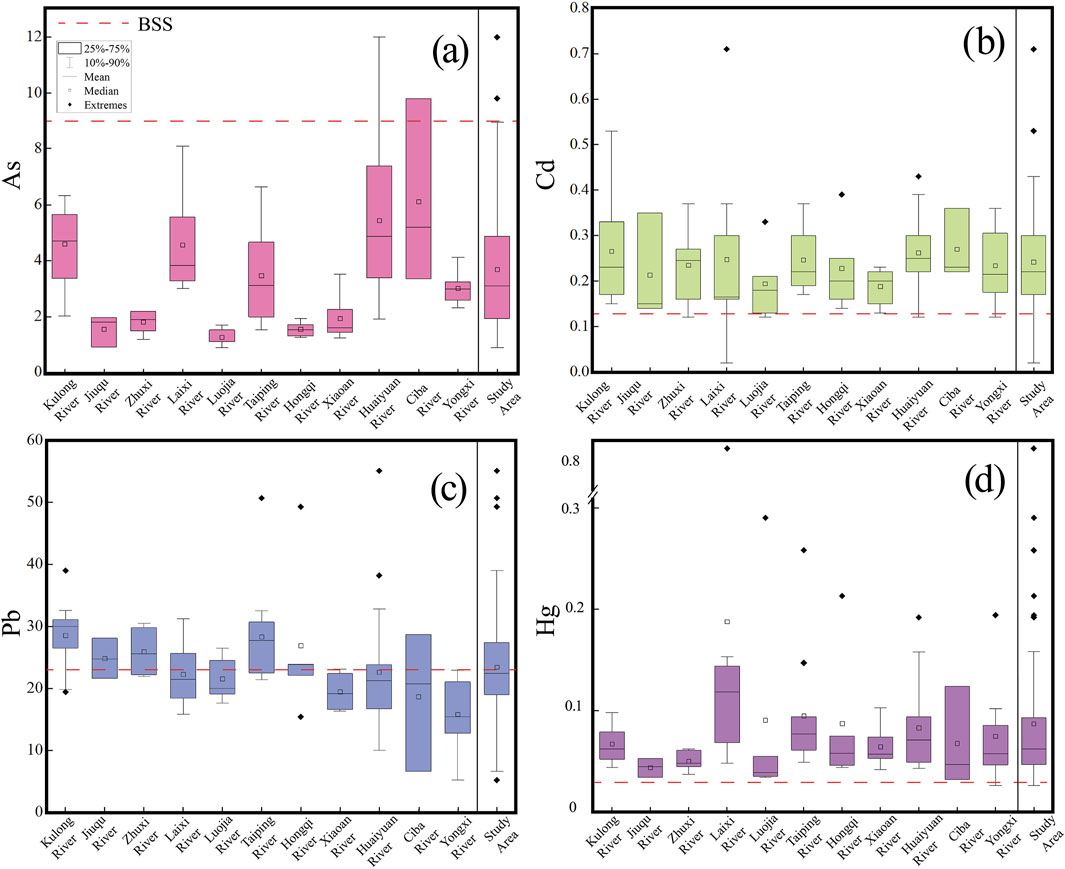
Figure 2. The content of HMs in sediments of different rivers within the study area. The dashed line represents BSS: (a) As, (b) Cd, (c) Pb, and (d) Hg.
3.1.2 Spatial distribution of HMs
The spatial distribution of HMs accumulation in river sediments is demonstrated in Figure 3. Among the four HMs, the As concentration in the spatial distribution rarely exceeds BSS, except in the upper reaches of the Huaiyuan River and the lower reaches of the Ciba River. Certain areas in the study region are naturally enriched in As, particularly in the upper reaches of the Huaiyuan River, which may be attributed to local geological structures and mineral weathering (Jia et al., 2018; Yang et al., 2007). Although localized mining activities may contribute to As levels to some extent, the fact that the concentrations are close to the BSS suggests that the slight exceedance of As is primarily due to the natural geochemical background. The concentrations of Cd and Hg in the study area’s river basins all exceed the BSS. Modern industrial processes frequently discharge wastewater and exhaust gases containing Cd and Hg, and these pollutants can enter water bodies either through atmospheric deposition or direct discharge, resulting in Cd and Hg levels in sediments that generally surpass the local background values in all river sections (Gao et al., 2025; Liu et al., 2023). Chen et al. found that mining, ore processing, smelting, and tailings disposal in several mining areas around Taojiang in Quannan County were often accompanied by the release of Cd and Hg (Chen et al., 2019). Li et al. reported that in the Han River Basin, high concentrations of Cd and Hg in sediments mainly originated from leakage of leachate from tailings storage facilities. These HMs entered river systems through surface runoff or groundwater migration, leading to their continuous accumulation in sediments across different river sections (Li et al., 2022c). Therefore, frequent mining activities and dense tailings storage, coupled with climate-induced heavy rainfall and enhanced runoff during the flood season, may jointly contribute to the high accumulation of Cd and Hg in river sediments. Under intensive agricultural activities, fertilizers and pesticides containing trace Cd and Hg enter rivers more readily during heavy rainfall events, which are increasingly frequent due to climate variability, thereby intensifying sediment contamination (Liu et al., 2024). Pb concentrations in sediments from Kulong River, Taiping River, and the upper Huaiyuan River are significantly higher than BSS. These rivers are located downstream of industrial parks or upstream of mining areas. Vehicle transport and production activities release exhaust and dust during hardware manufacturing and mining. These emissions are important sources of Pb input (Hanfi et al., 2019; Liu et al., 2023; Nawrot et al., 2020). Therefore, traffic emissions and industrial activities are likely the main reasons for Pb accumulation in these sediments.
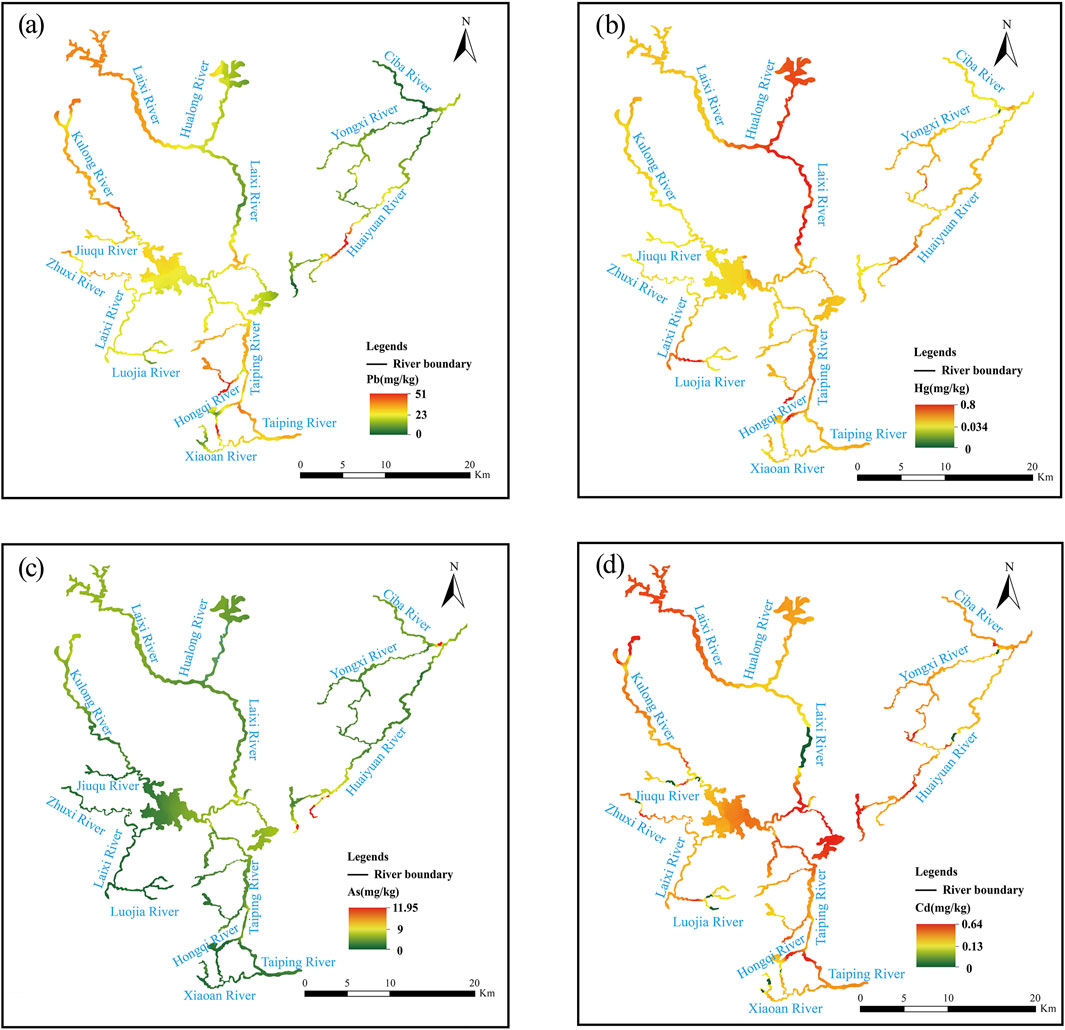
Figure 3. Spatial distribution of HMs concentration in sediments: (a) As, (b) Cd, (c) Pb, and (d) Hg.
3.2 Pollution levels of HMs in sediments
According to Igeo classification standards, As and Pb levels in river sediments across the study area are generally within the unpolluted category, while Cd levels range from unpolluted to slightly polluted. Hg exhibits the highest pollution levels, with 48.2% of sampling sites classified as slightly polluted, 15.3% as moderately polluted, 3.5% as moderately to heavily polluted, and 1.1% as heavily polluted. The results indicate that sedimentary As exhibits unpolluted to low pollution levels, while Cd, Pb, and Hg show varying degrees of contamination. As and Pb concentrations are relatively high in the Huaiyuan River, whereas Cd and Hg reach peak levels in the Laixi River. This suggests both rivers were strongly affected by human activities. The Laixi River is influenced by the hardware industrial park, whereas the Huaiyuan River flows through areas with intensive mining. Industrial activities may mainly contribute to As and Pb enrichment. Mining is likely the main source of Cd and Hg pollution. The Igeo of Cd and Hg were greater than 0 in all rivers. This indicates that sediments in all 11 rivers were polluted to different degrees. In Laixi River, Luojia River, Taiping River, and Hongqi River, Igeo of Hg was greater than 2. These four rivers may be severely polluted by Hg (Figure 4).
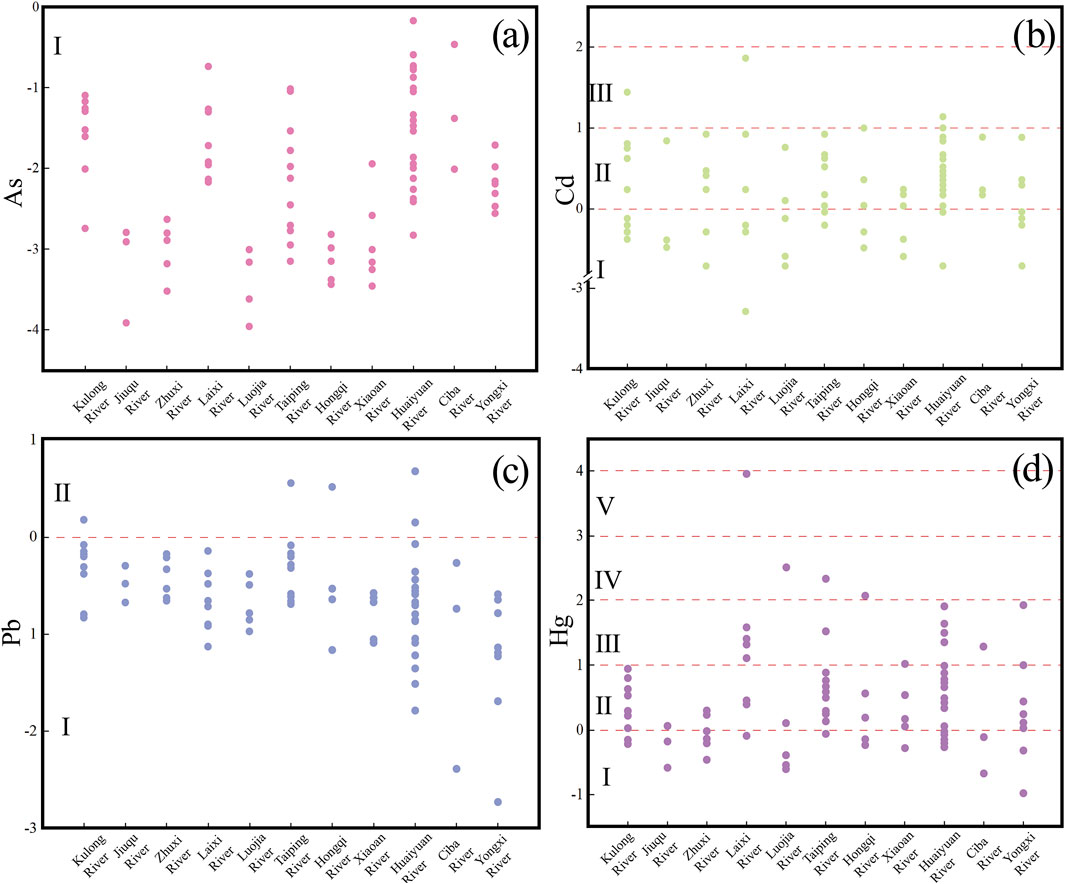
Figure 4. Igeo values of HMs in sediments along the different rivers. The dashed line represents classification line. I-Practically uncontaminated, II-Uncontaminated to moderately contaminated, III-Moderately contaminated, IV-Moderately to strongly contaminated, V-Strongly contaminated: (a) As, (b) Cd, (c) Pb, and (d) Hg.
As shown in Figures 5A-D, the concentrations of As, Cd, and Pb in sediments from all 11 rivers were below their corresponding PEL values. This indicates that the overall biological toxicity risk from these metals is low. However, several samples showed As, Pb, and Hg concentrations exceeding their TEL values. One sample showed Hg concentration above the PEL value. These results suggest that As, Pb, and Hg may occasionally cause adverse biological effects. The sampling period of this study coincided with the flood season. Heavy rainfall during this period may have increased surface runoff, disturbed sediments, and promoted pollutant resuspension (Li et al., 2022a; Zhang et al., 2018). These processes may enhance the mobility and bioavailability of HMs, especially As, Cd, and Hg. Based on sediment quality guideline thresholds, As, Cd, and Hg are identified as the main ecological risk elements in the study area (Ciszewski, 2001; Wu et al., 2017). Their high-risk zones are mainly located in the Laixi River, Huaiyuan River, and Taiping River. These rivers are more susceptible to HMs input and sediment disturbance during the flood season. Sediments in these zones are more likely to release HMs, posing potential threats to aquatic ecosystems.
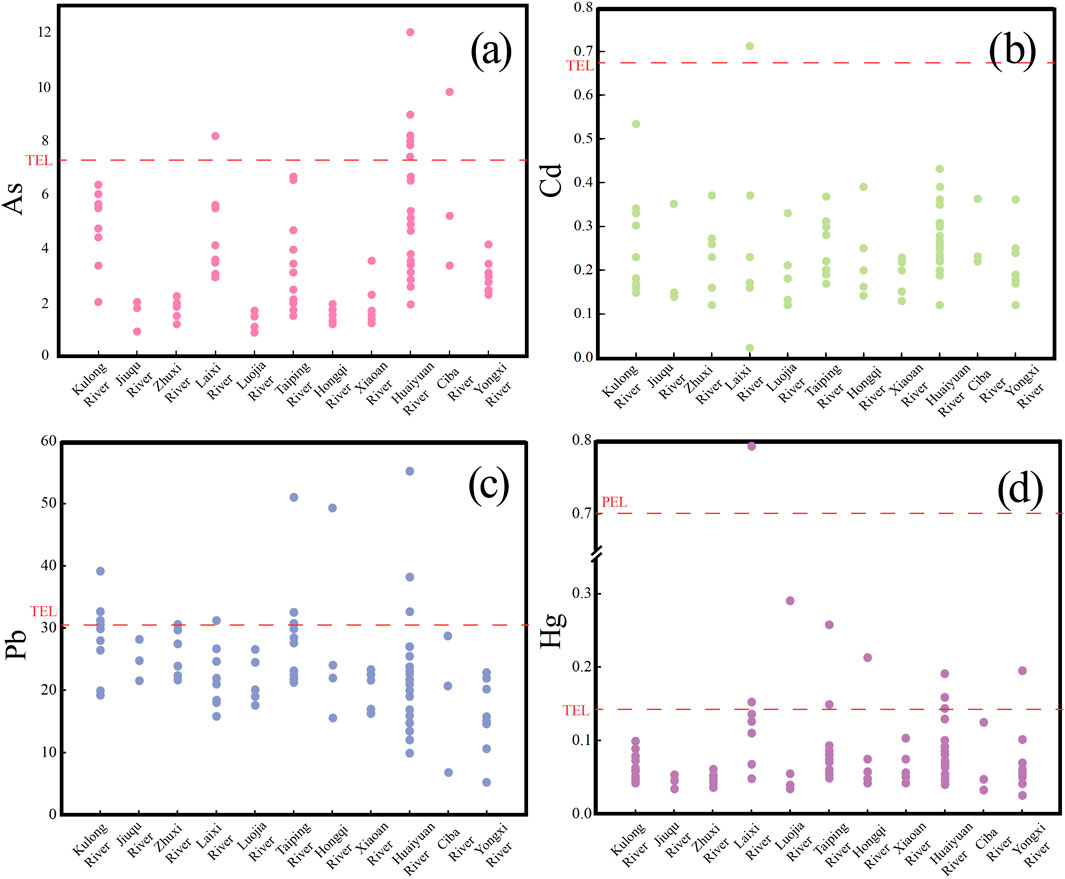
Figure 5. SQGs of HMs in sediments along the different rivers. The dashed line represents classification line: (a) As, (b) Cd, (c) Pb, and (d) Hg.
3.3 Ecological risk levels of HMs in sediments
The Er considers the toxicity response coefficients and biological sensitivity of different HMs (Gąsiorek et al., 2017; Wang et al., 2023). It was used to evaluate the ecological risks of HMs in sediments from 11 rivers in the study area. The mean values of the individual potential ecological risk indices for the four HMs decrease in the following order: Hg (102.49) > Cd (55.79) > Pb (5.09) > As (4.09). Among them, the average Er value for Cd falls within the moderate ecological risk category (40 ≤ Er < 80), Hg falls within the strong ecological risk category (80 ≤ Er < 160), while As and Pb are both classified as slight ecological risk. Cd and Hg had the highest values in the Laixi River, indicating the highest potential ecological risks in this basin (Figure 6).
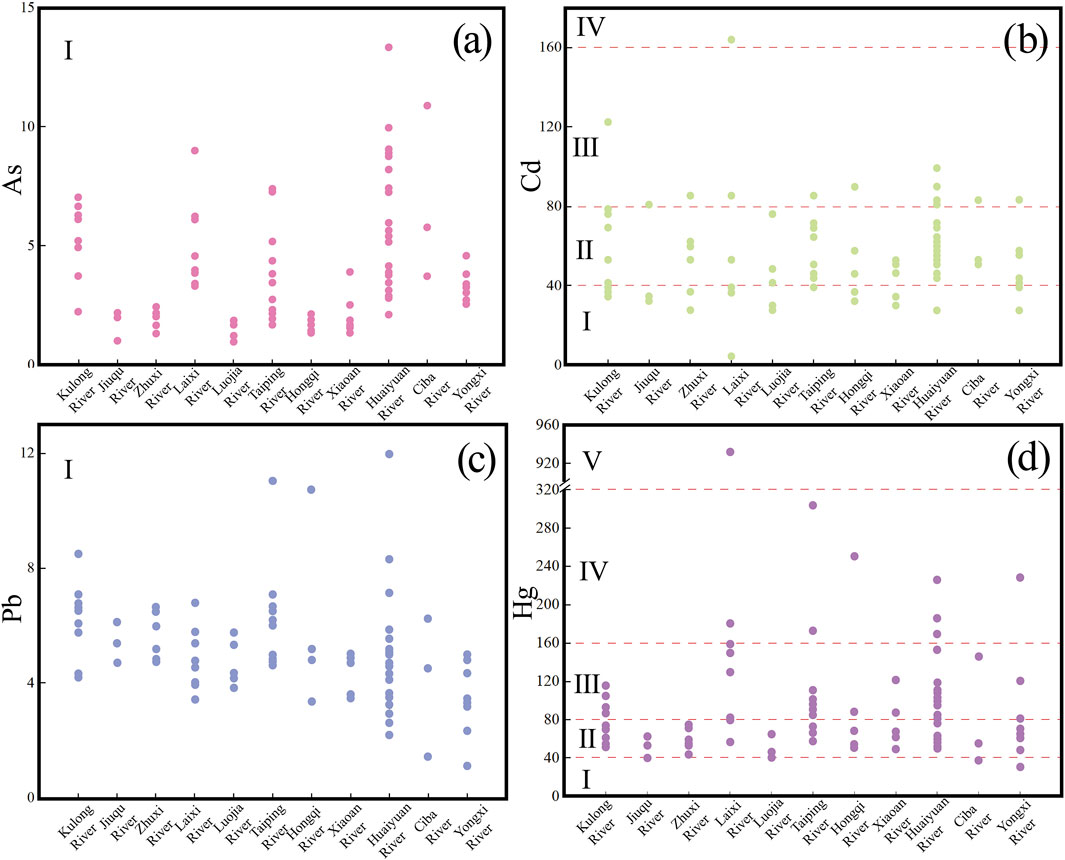
Figure 6. Er values of HMs in sediments along the different rivers. The dashed line represents classification line. I-Slight ecological risk, II-Moderate ecological risk, III-Strong ecological risk, IV-Very strong ecological risk, V-Extremely strong ecological risk: (a) As, (b) Cd, (c) Pb, and (d) Hg.
The spatial distribution of RI for HMs in sediments is shown in Figure 7. The RI values in the upper reaches of the Huaiyuan River and the Kulong River indicate medium-high to high ecological risk. Several historical and active mines, quarries, and tailings storage sites are located in this area. Mining activities release dust, wastewater, and leachate containing HMs. These pollutants are transported into river systems via surface runoff. During the flood season, intensified precipitation and frequent flood events further accelerate the mobilization of these contaminants, resulting in significantly elevated concentrations of Cd and Hg in sediments (Chen et al., 2019; Li et al., 2022c). Cd and Hg have high toxic response factors. These two elements are the key contributors to elevated RI values. Their accumulation directly increases the ecological risk level in this region. The RI values in the Laixi River and Taiping River basins are generally at strong to very strong levels. These basins contain concentrated industrial parks for hardware processing, electroplating, and acid washing. Long-term emissions from these parks affect sediment quality (Jia et al., 2018; Yang et al., 2007). Industrial wastewater treatment has improved in recent years. However, some enterprises still discharge illegally. Mixed drainage and leakage from aging pipelines are also observed. These issues, when combined with climate-driven heavy rainfall, enhance the input of Cd and Hg into sediments through both surface runoff and groundwater recharge (Ciszewski, 2001). As a result, ecological risks continue to accumulate.
In contrast, the Zhuxi River and Luojia River basins are located at the edge of the study area. These areas do not have significant mining or industrial activities. Land use is dominated by agriculture. The rivers have fast flow and strong hydrodynamics. The ecological risk in these areas remains low. These regions represent the background condition of non-industrial areas.
Cd and Hg are the main contributors to sediment-related ecological risk in the study area. These elements show high biological toxicity and strong mobility. They easily bind with organic matter or sulfur and accumulate in sediments. They contribute significantly to ecological risk in many sampling sections. The toxic response factors of Cd and Hg are 30 and 40, respectively. These values are much higher than those of other elements. Therefore, even at moderate concentrations, their ecological impacts should not be ignored. Future monitoring should focus on Cd and Hg pollution in sediments, especially in mining zones, industrial parks, and downstream regions, and should incorporate hydrological and climatic variables to better assess risk dynamics under changing environmental conditions.
3.4 Source identification and apportionment of HMs in sediments
3.4.1 Source identification results
The Kaiser-Meyer-Olkin (KMO) measure and Bartlett’s test of sphericity were applied to the HMs concentrations across all sampling sites in the study area. The KMO value was 0.59, and Bartlett’s test yielded a significance level of 0.011, indicating that the data are suitable for PCA (Li et al., 2022b; Xie et al., 2022). The three principal components extracted accounted for a cumulative 83.5% of the total variance, effectively capturing the variability in HMs concentrations within the sediment samples (Table 1). The component matrix revealed that Cd and Pb exhibited significant loadings on PC1, explaining 38.7% of the total variance. Hg was prominent on PC2, accounting for 24.2% of the variance, while As was dominant on PC3, explaining 20.6% of the variance. Considering the spatial distribution and risk assessments of Cd and Pb in the study area, elevated risks were identified in mining and industrial park regions. Previous studies suggest that Cd primarily originates from industrial discharges and non-ferrous metal smelting, while Pb is commonly associated with various industrial processes (Liu et al., 2023) and vehicular emissions (Hanfi et al., 2019; Nawrot et al., 2020). Therefore, PC1 is indicative of industrial and transportation-related sources. Hg exhibited the highest loading on PC2. Based on its spatial distribution and risk assessment, higher risks were observed in mining zones, whereas lower risks were noted in areas surrounding industrial parks and downstream regions. This suggests that PC2 is predominantly influenced by mining activities. As posed minimal ecological risks across the study area, with only a few samples in mining zones showing low risk levels. The samples exceeding background values were located upstream of the industrial park, eliminating industrial interference. Thus, PC3 is primarily governed by geological background factors.
3.4.2 Source apportionment results
PMF was further applied to quantitatively apportion the source contributions of HMs in river sediments. PMF model, as a receptor model capable of identifying pollutant sources and quantifying their contributions, has been widely applied in environmental studies (Dong et al., 2019; Liu et al., 2019). To guarantee result accuracy, the residual matrix E was controlled by minimizing the Qrobust/Qture ratio, various indicators were tested, and the system was run more than 20 times to achieve the best solution (Dong et al., 2019). In this study, the PMF model extracted three factors that resulted in the lowest Q value, with residuals between −1 and +1, demonstrating the model’s reliable and precise source apportionment (Detailed parameters are presented in Supplementary Tables S6–S10). The quantitative source apportionment results obtained from PMF are presented in Figure 8.
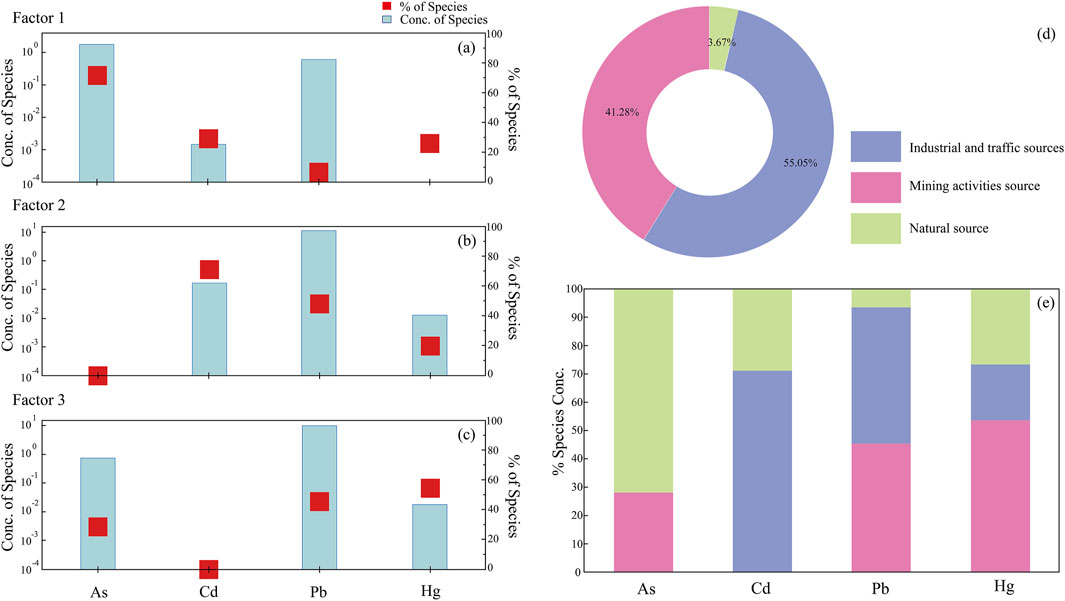
Figure 8. Source apportionment results of HMs based on PMF model. (a) Factor 1; (b) Factor 2; (c) Factor 3; (d) Source contributions; (e) Species contribution.
Factor 1 accounts for 3.67% of the total contribution and is primarily characterized by As (71.7%). In this study, the ecological risk of As is low, and the sampling points exceeding background values are located upstream of the industrial park, unaffected by industrial activities. Natural factors are the main contributors to these HMs concentrations. Therefore, it is presumed that factor 1 may be an natural source of pollution.
Factor 2 accounts for 55.05% of the total contribution and is primarily composed of Cd (70.9%) and Pb (47.9%). Industrial emissions and vehicular exhaust are the primary contributors to these HMs concentrations (Hanfi et al., 2019; Liu et al., 2023; Nawrot et al., 2020). Field investigation showed that industrial parks and quarries are distributed in areas with high Cd and Pb levels. Wastewater and exhaust gases from metallurgical, electroplating, and acid-washing processes, as well as vehicle emissions, enter the water environment through atmospheric deposition. Therefore, it is speculated that factor 2 may be a combined source of industrial pollution and partial traffic pollution, which is consistent with PC1 results.
Factor 3 accounts for 41.28% of the total contribution and primarily consists of Hg (53.9%). Combining the results of principal component analysis and field observations, mining activities are identified as the primary source of Hg. Therefore, Factor3 are attributed to mining-related sources. The PMF model analysis indicates that surface soil contamination is primarily influenced by natural sources, industrial-traffic sources, and mining activities, aligning with the conclusions drawn from PCA.
4 Conclusion
In this study, Cd and Hg showed similar spatial distribution patterns, with high concentrations mainly occurring downstream of the mining belt and industrial park, while Pb was more strongly influenced by the industrial and vehicle transport, and As anomalies were limited to localized upstream areas within Huaiyuan River. Igeo, SQGs and RI revealed relatively severe HMs pollution in sediments of four major rivers in Dazu District, with Hg reaching slight to very strong pollution levels—particularly in the midstream of the Laixi River—while As and Pb remained at slight ecological risk. The overall ecological risk was moderate, but areas near the industrial park, mining zones, and their downstream sections exhibited strong to very strong ecological risks. Seasonal climatic factors, especially intense rainfall and flooding during the flood season, enhanced surface runoff and sediment resuspension. These processes promoted the mobilization and redistribution of HMs, thereby exacerbating their contamination and ecological risks. Source identification and apportionment using PCA and PMF indicated that natural inputs, industrial activities, and mining operations were the main contributors to HMs contamination. Source apportionment results indicate that natural sources account for 3.67%, industrial and traffic-related sources contribute 55.05%, and mining activities contribute 41.28%. Among them, Cd and Pb were primarily influenced by vehicle emissions and industrial activities, Hg was mainly linked to mining, and As was derived from both natural and anthropogenic sources.
5 Future outlook
This study used sediment samples collected once during the summer. These data reflect the status of HMs contamination in 11 rivers in the study area. However, the absence of multi-seasonal or multi-year data limits the ability to assess temporal variations. Seasonal changes in metal concentrations and ecological risks driven by hydrological or anthropogenic factors remain uncertain. Future studies should include long-term sampling campaigns conducted in different seasons and under varying hydrological conditions. This approach can help capture the spatiotemporal dynamics and transport mechanisms of sediment-bound HMs. In addition, long-term monitoring is essential for evaluating the impacts of climate-related extreme weather events, such as floods and droughts, on the resuspension and remobilization of HMs. These efforts will provide scientific support for watershed-scale risk assessment and adaptive environmental management.
Data availability statement
The original contributions presented in the study are included in the article/Supplementary Material, further inquiries can be directed to the corresponding author.
Author contributions
CS: Software, Writing – review and editing, Investigation, Visualization, Data curation, Writing – original draft, Validation, Project administration, Formal Analysis. SH: Data curation, Investigation, Software, Writing – review and editing, Formal Analysis. BH: Validation, Writing – review and editing, Data curation, Investigation, Visualization. ZL: Visualization, Writing – review and editing, Investigation, Software. ZY: Conceptualization, Resources, Writing – review and editing, Methodology, Supervision, Project administration. JT: Project administration, Supervision, Validation, Writing – review and editing. SY: Writing – review and editing, Methodology. JZ: Formal Analysis, Writing – review and editing.
Funding
The author(s) declare that no financial support was received for the research and/or publication of this article.
Acknowledgments
We are grateful acknowledge Peng Wang, Ziyang Ding and Jie Ren from the China University of Geosciences (Beijing), for participating in the discussions and providing constructive comments.
Conflict of interest
The authors declare that the research was conducted in the absence of any commercial or financial relationships that could be construed as a potential conflict of interest.
Generative AI statement
The author(s) declare that no Generative AI was used in the creation of this manuscript.
Publisher’s note
All claims expressed in this article are solely those of the authors and do not necessarily represent those of their affiliated organizations, or those of the publisher, the editors and the reviewers. Any product that may be evaluated in this article, or claim that may be made by its manufacturer, is not guaranteed or endorsed by the publisher.
Supplementary material
The Supplementary Material for this article can be found online at: https://www.frontiersin.org/articles/10.3389/fenvs.2025.1646212/full#supplementary-material
References
Ali, H., and Khan, E. (2019). Trophic transfer, bioaccumulation, and biomagnification of non-essential hazardous heavy metals and metalloids in food chains/webs—Concepts and implications for wildlife and human health. Hum. Ecol. Risk Assess. An Int. J. 25 (6), 1353–1376. doi:10.1080/10807039.2018.1469398
Ao, L., Chang, R., Tang, Y., and Zhang, S. (2024). Ecological risk assessment and source tracing of heavy metals in surface sediments of a hilly riverine reservoir in chongqing, China. Environ. Sci. Eur. 36 (1), 69. doi:10.1186/s12302-024-00887-9
Chen, M., Li, F., Tao, M., Hu, L., Shi, Y., and Liu, Y. (2019). Distribution and ecological risks of heavy metals in river sediments and overlying water in typical mining areas of China. Mar. Pollut. Bull. 146, 893–899. doi:10.1016/j.marpolbul.2019.07.029
Ciszewski, D. (2001). Flood-related changes in heavy metal concentrations within sediments of the biaa Przemsza river. Geomorphology, 40(3), 205–218. doi:10.1016/S0169-555X(01)00044-7
Dai, L., Wang, L., Li, L., Liang, T., Zhang, Y., Ma, C., et al. (2018). Multivariate geostatistical analysis and source identification of heavy metals in the sediment of Poyang Lake in China. Sci. Total Environ. 621, 1433–1444. doi:10.1016/j.scitotenv.2017.10.085
Ding, Z., Han, G., and hu, J. (2025). Characteristics of heavy metals in the hair of firefighters: concentration dynamics and elemental interactions. Environ. Geochem. Health 47 (3), 90. doi:10.1007/s10653-025-02410-2
Dong, B., Zhang, R., Gan, Y., Cai, L., Freidenreich, A., Wang, K., et al. (2019). Multiple methods for the identification of heavy metal sources in cropland soils from a resource-based region. Sci. Total Environ. 651, 3127–3138. doi:10.1016/j.scitotenv.2018.10.130
Frogner-Kockum, P., Göransson, G., and Haeger-Eugensson, M. (2020). Impact of Climate Change on Metal and Suspended Sediment Concentrations in Urban Waters [Original Research]. Front. Environ. Sci. 8–2020. doi:10.3389/fenvs.2020.588335
Gao, C., Yu, J., Min, X., Cheng, A., Hong, R., and Zhang, L. (2018). Heavy metal concentrations in sediments from Xingyun lake, southwestern China: implications for environmental changes and human activities. Environ. Earth Sci. 77 (19), 666. doi:10.1007/s12665-018-7840-5
Gao, X., Han, G., Zhang, S., and Zeng, J. (2025). Sources, water quality, and potential risk assessment of heavy metal contamination in typical megacity River: insights from monte carlo simulation. Water 17 (2), 224. doi:10.3390/w17020224
Gąsiorek, M., Kowalska, J., Mazurek, R., and Pająk, M. (2017). Comprehensive assessment of heavy metal pollution in topsoil of historical urban park on an example of the planty park in krakow (poland). Chemosphere 179, 148–158. doi:10.1016/j.chemosphere.2017.03.106
Gu, X., Liu, Y., Yang, S., Sun, J., Wang, Q., Wang, H., et al. (2024). Characteristics and sources of heavy metals pollution in surface sediments: an integrated land–sea comparative analysis in dingzi Bay, south yellow sea. Water 16 (12), 1692. doi:10.3390/w16121692
Hakanson, L. (1980). An ecological risk index for aquatic pollution control.a sedimentological approach. Water Res. 14 (8), 975–1001. doi:10.1016/0043-1354(80)90143-8
Hanfi, M. Y., Mostafa, M. Y. A., and Zhukovsky, M. V. (2019). Heavy metal contamination in urban surface sediments: sources, distribution, contamination control, and remediation. Environ. Monit. Assess. 192 (1), 32. doi:10.1007/s10661-019-7947-5
Jia, Z., Feng, H., Bao, L., and Zhang, Y. (2018). Distribution characteristics and risk assessment of soil heavy metals in Northwest chongqing. J. Southwest Univ. Nat. Sci. Ed. 40 (7), 106–114. [Article]. doi:10.13718/j.cnki.xdzk.2018.07.016
Kachoueiyan, F., Karbassi, A., Nasrabadi, T., Rashidiyan, M., and De-la-Torre, G. E. (2024). Speciation characteristics, ecological risk assessment, and source apportionment of heavy metals in the surface sediments of the Gomishan wetland. Mar. Pollut. Bull. 198, 115835. doi:10.1016/j.marpolbul.2023.115835
Le, T. V., and Nguyen, B. T. (2024). Heavy metal pollution in surface water bodies in provincial Khanh Hoa, Vietnam: pollution and human health risk assessment, source quantification, and implications for sustainable management and development. Environ. Pollut. 343, 123216. doi:10.1016/j.envpol.2023.123216
Li, C., Wang, H., Liao, X., Xiao, R., Liu, K., Bai, J., et al. (2022a). Heavy metal pollution in coastal wetlands: a systematic review of studies globally over the past three decades. J. Hazard. Mater. 424, 127312. doi:10.1016/j.jhazmat.2021.127312
Li, W., Qian, H., Xu, P., Zhang, Q., Chen, J., Hou, K., et al. (2022b). Distribution characteristics, source identification and risk assessment of heavy metals in surface sediments of the Yellow river, China. CATENA 216, 106376. doi:10.1016/j.catena.2022.106376
Li, X., Bing, J., Zhang, J., Guo, L., Deng, Z., Wang, D., et al. (2022c). Ecological risk assessment and sources identification of heavy metals in surface sediments of a river–reservoir system. Sci. Total Environ. 842, 156683. doi:10.1016/j.scitotenv.2022.156683
Lin, Q., Liu, E., Zhang, E., Li, K., and Shen, J. (2016). Spatial distribution, contamination and ecological risk assessment of heavy metals in surface sediments of Erhai Lake, a large eutrophic Plateau lake in southwest China. CATENA 145, 193–203. doi:10.1016/j.catena.2016.06.003
Liu, P., Wu, Q., Hu, W., Tian, K., Huang, B., and Zhao, Y. (2023). Comparison of heavy metals in riverine and estuarine sediments in the lower Yangtze river: distribution, sources, and ecological risks. Environ. Technol. & Innovation 30, 103076. doi:10.1016/j.eti.2023.103076
Liu, Q., Jia, Z., Li, S., and Hu, J. (2019). Assessment of heavy metal pollution, distribution and quantitative source apportionment in surface sediments along a partially mixed Estuary (Modaomen, China). Chemosphere 225, 829–838. doi:10.1016/j.chemosphere.2019.03.063
Liu, S., Wu, K., Yao, L., Li, Y., Chen, R., Zhang, L., et al. (2024). Characteristics and correlation analysis of heavy metal distribution in China's freshwater aquaculture pond sediments. Sci. Total Environ. 931, 172909. doi:10.1016/j.scitotenv.2024.172909
Liu, X., Li, D., and Song, G. (2017). Assessment of heavy metal levels in surface sediments of estuaries and adjacent coastal areas in China. Front. Earth Sci. 11 (1), 85–94. doi:10.1007/s11707-016-0569-0
Liu, Y., Yang, C., Tan, S., Zhou, H., and Zeng, W. (2022). An approach to assess spatio-temporal heterogeneity of rural ecosystem health: a case study in Chongqing mountainous area, China. Ecol. Indic. 136, 108644. doi:10.1016/j.ecolind.2022.108644
Macdonald, D. D., Carr, R. S., Calder, F. D., Long, E. R., and Ingersoll, C. G. (1996). Development and evaluation of sediment quality guidelines for Florida coastal waters. Ecotoxicology 5 (4), 253–278. doi:10.1007/BF00118995
Nawrot, N., Wojciechowska, E., Rezania, S., Walkusz-Miotk, J., and Pazdro, K. (2020). The effects of urban vehicle traffic on heavy metal contamination in road sweeping waste and bottom sediments of retention tanks. Sci. Total Environ. 749, 141511. doi:10.1016/j.scitotenv.2020.141511
Net, S., El-Osmani, R., Prygiel, E., Rabodonirina, S., Dumoulin, D., and Ouddane, B. (2015). Overview of persistent organic pollution (PAHs, Me-PAHs and PCBs) in freshwater sediments from Northern France. J. Geochem. Explor. 148, 181–188. doi:10.1016/j.gexplo.2014.09.008
Nie, J., Feng, H., Witherell, B. B., Alebus, M., Mahajan, M. D., Zhang, W., et al. (2018). Causes, assessment, and treatment of nutrient (N and P) pollution in Rivers, estuaries, and coastal waters. Curr. Pollut. Rep. 4 (2), 154–161. doi:10.1007/s40726-018-0083-y
Nieva, N. E., Borgnino, L., and García, M. G. (2018). Long term metal release and acid generation in abandoned mine wastes containing metal-sulphides. Environ. Pollut. 242, 264–276. doi:10.1016/j.envpol.2018.06.067
Poot, A., Gillissen, F., and Koelmans, A. A. (2007). Effects of flow regime and flooding on heavy metal availability in sediment and soil of a dynamic river system. Environ. Pollut. 148 (3), 779–787. doi:10.1016/j.envpol.2007.01.045
Ren, J., Han, G., Liu, J., Zhang, S., and Gao, X. (2025). Distribution and controlling factors of dissolved inorganic carbon in urban rivers of a North China megacity: insights from δ13CDIC. J. Environ. Manag. 373, 123681. doi:10.1016/j.jenvman.2024.123681
Saxena, V. (2025). Water quality, air pollution, and climate change: investigating the environmental impacts of industrialization and urbanization. Water, Air, & Soil Pollut. 236 (2), 73. doi:10.1007/s11270-024-07702-4
Schwanen, C. A., Kronsbein, P. M., Balik, B., and Schwarzbauer, J. (2023). Dynamic transport and distribution of organic pollutants in water and sediments of the rur river. Water, Air, & Soil Pollut. 235 (1), 9. doi:10.1007/s11270-023-06786-8
Shen, C., Wang, W.-J., Sha, C.-Y., Xie, Y.-Q., Wang, M., and Wu, J. (2024). Distribution characteristics, source analysis and ecological risk assessment of heavy metals in the typical industry reclaimed soil. Environ. Sci. 45 (3), 1769–1780. doi:10.13227/j.hjkx.202303085
Shi, C.-y., Liang, M., and Feng, B. (2016). Average background values of 39 chemical elements in stream sediments of China. Earth Sci. 41 (2), 234–251. doi:10.3799/dqkx.2016.018
Sousa, J. C. G., Ribeiro, A. R., Barbosa, M. O., Pereira, M. F. R., and Silva, A. M. T. (2018). A review on environmental monitoring of water organic pollutants identified by EU guidelines. J. Hazard. Mater. 344, 146–162. doi:10.1016/j.jhazmat.2017.09.058
Sultana, S., Sultana, N., Moniruzzaman, M., Dastagir, M. R., and Hossain, M. K. (2025). Unmasking heavy metal contamination: tracing, risk estimating and source fingerprinting from coastal sediments of the Payra river in Bangladesh. Mar. Pollut. Bull. 211, 117455. doi:10.1016/j.marpolbul.2024.117455
Tu, Y.-J., Luo, P.-C., Li, Y.-L., Liu, J., Sun, T.-T., Li, G.-J., et al. (2023). Seasonal heavy metal speciation in sediment and source tracking via Cu isotopic composition in Huangpu river, Shanghai, China. Ecotoxicol. Environ. Saf. 260, 115068. doi:10.1016/j.ecoenv.2023.115068
Wang, F., Wang, F., Yang, H., Yu, J., and Ni, R. (2023). Ecological risk assessment based on soil adsorption capacity for heavy metals in Taihu basin, China. Environ. Pollut. 316, 120608. doi:10.1016/j.envpol.2022.120608
Wu, Q., Qi, J., and Xia, X. (2017). Long-term variations in sediment heavy metals of a reservoir with changing trophic states: implications for the impact of climate change. Sci. Total Environ. 609, 242–250. doi:10.1016/j.scitotenv.2017.04.041
Wu, X., Yang, K., Lu, J., Li, B., Li, Y., Zhang, Y., et al. (2025). Contamination and ecological risk of heavy metals in sediments of urban rivers in a typical economic development zone, southern China. J. Environ. Sci. 153, 264–274. doi:10.1016/j.jes.2024.09.006
Xie, F., Yu, M., Yuan, Q., Meng, Y., Qie, Y., Shang, Z., et al. (2022). Spatial distribution, pollution assessment, and source identification of heavy metals in the Yellow river. J. Hazard. Mater. 436, 129309. doi:10.1016/j.jhazmat.2022.129309
Yang, Q., Li, H., and Long, F. (2007). Heavy metals of vegetables and soils of vegetable bases in Chongqing, Southwest China. Environ. Monit. Assess. 130 (1), 271–279. doi:10.1007/s10661-006-9395-2
Yiika, L. P., Jean-Lavenir, N. M., Suh, G. C., Nkemasong, J. A., Eseya Mengu Junior, E., Kehding, F. B., et al. (2023). Distribution, sources, and eco-toxicological assessment of potentially toxic metals in river sediments of nkwen area (Cameroon volcanic line). Water, Air, & Soil Pollut. 235 (1), 16. doi:10.1007/s11270-023-06830-7
Zhang, D., Yan, K., Liu, Y., and Naidu, R. (2022). Effects of Phosphate, red mud, and biochar on As, Cd, and Cu immobilization and enzymatic activity in a Co-Contaminated soil. Processes 10 (6), 1127. doi:10.3390/pr10061127
Zhang, H., Huo, S., Yeager, K. M., Xi, B., Zhang, J., He, Z., et al. (2018). Accumulation of arsenic, mercury and heavy metals in lacustrine sediment in relation to eutrophication: impacts of sources and climate change. Ecol. Indic., 93, 771–780. doi:10.1016/j.ecolind.2018.05.059
Zhao, Y.-p., Wu, R., Cui, J.-l., Gan, S.-c., Pan, J.-c., and Guo, P.-r. (2020). Improvement of water quality in the Pearl river Estuary, China: a long-term (2008–2017) case study of temporal-spatial variation, source identification and ecological risk of heavy metals in surface water of Guangzhou. Environ. Sci. Pollut. Res. 27 (17), 21084–21097. doi:10.1007/s11356-020-08378-z
Keywords: heavy metals, industrialization, sediments, ecological risks, source apportionment, flood season
Citation: Shen C, Huang S, Huang B, Liu Z, Yi Z, Tang J, Yin S and Zhang J (2025) Distribution characteristics, risks and sources of heavy metals in surface sediments from typical industrial and mining complex area in Southwest China. Front. Environ. Sci. 13:1646212. doi: 10.3389/fenvs.2025.1646212
Received: 13 June 2025; Accepted: 30 June 2025;
Published: 14 July 2025.
Edited by:
Zeynep Eren, Atatürk University, TürkiyeCopyright © 2025 Shen, Huang, Huang, Liu, Yi, Tang, Yin and Zhang. This is an open-access article distributed under the terms of the Creative Commons Attribution License (CC BY). The use, distribution or reproduction in other forums is permitted, provided the original author(s) and the copyright owner(s) are credited and that the original publication in this journal is cited, in accordance with accepted academic practice. No use, distribution or reproduction is permitted which does not comply with these terms.
*Correspondence: Zongwang Yi, eWl6d18xMDdAMTYzLmNvbQ==
 Chuan Shen
Chuan Shen Sheng Huang
Sheng Huang Zongwang Yi
Zongwang Yi